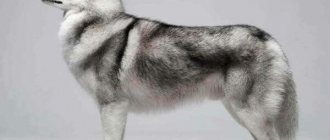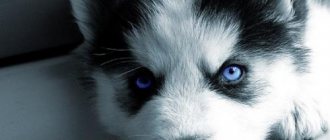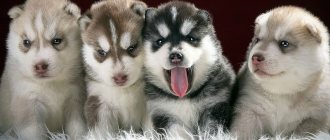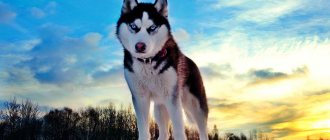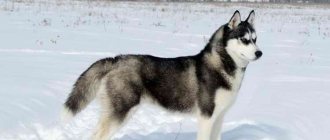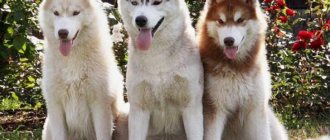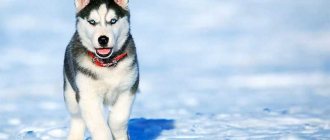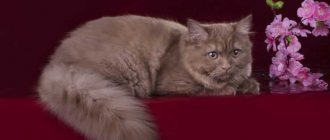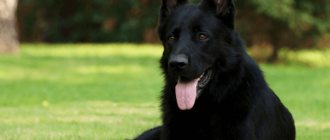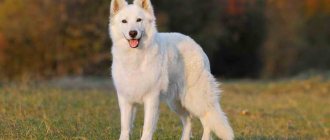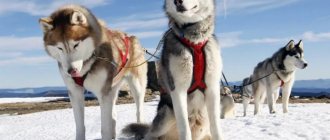Husky, having long ago ceased to be just a working sled dog, has turned into a popular exhibition and sporting breed; these dogs are also owned simply as a pet.
The fashion for them has led to the fact that the husky has become recognizable and even small children know that these animals look like wolves, that they have erect ears and blue eyes.
But this popularity has given rise to misconceptions, for example, many people think that there are other types of huskies or that these dogs only come in gray and black.
So are there any types of husky? What are they? And what should standard representatives of this breed look like?
Description of the breed
medium-sized sled dog , distinguished by endurance, good speed qualities and the ability to navigate the terrain well.
Bred by tribes inhabiting the northern part of the Far Eastern region of Russia in ancient times, the breed developed and improved under harsh weather conditions and almost natural selection, since human intervention in the selection of pairs was insignificant.
Being left to their own devices in the warm season, sled dogs were forced to get their own food , thanks to which they developed a hunting instinct, which modern representatives of this breed have inherited.
Since in those tribes it was not customary to divide property and territory into theirs and someone else’s, people did not need sled dogs to have guarding or protective qualities.
NOTE!
The modern husky has a friendly and affable character, he is active and playful, although sometimes he is prone to mischief.
These dogs' inherent loyalty to their owners, love of children and ability to adapt make them suitable as family pets.
However, you need to take into account that training a husky may not be such a simple matter, since these dogs are very freedom-loving and independent, and if something does not suit them, they can become stubborn and stop obeying their owner.
Why do huskies howl?
Howling is not a strange behavior for the breed. Most dogs show their longing for their beloved owner in this way if he is absent for a long time. However, there may be other reasons. Experts say that howling can be a sign of:
- uncomfortable state. For example, if the pet is locked in an enclosure;
- anxiety;
- pain or injury;
- designation of their territory. This is especially true for males;
- singing, which gives the dog pleasure.
Important! You shouldn't scold your dog for howling. After all, where did such a breed come from? They have distantly common genes with wolves, perhaps in a domestic pet they manifest themselves this way.
Accepted standard
| Characteristics | Description |
| Dimensions | Males - 53.5-60 cm Bitches - 50.5-56 cm |
| Weight | Males - 20.5-28 kg Bitches - 15.5-23 kg |
| Body Format | Close to square, while the length of the body does not exceed the height at the withers by more than 1-3 cm. |
| Head | Harmonious and proportionate to the body, moderately wide in the forehead, it tapers to the muzzle, the length of which should be approximately equal to the skull. |
| Ears | Medium in size, erect, similar in shape to isosceles triangles, slightly rounded at the tips. |
| Eyes | Almond-shaped and slightly oblique, their color can be brownish, blue, amber or olive. Also, huskies are allowed to have different eyes, when one eye is different in color from the other. |
| Nose | Depending on the color, it can be black, brown or almost flesh-colored; “snowy” pigmentation is also acceptable. |
| Frame | Harmonious and correct, not too light, but not massive either, with well-developed muscles and a moderately voluminous chest. |
| Limbs | Straight, parallel and strong, not too wide apart. |
| Tail | It looks like a fox's, when at rest it is lowered down, in a state of excitement it rises above the back in the shape of a sickle. |
| Wool | Two-layer, medium length, consists of a soft undercoat and a coarser outer coat. |
Maintenance, care and nutrition
Siberians suffer from limited space, so it’s unlikely that anyone will be able to make a “sofa cushion” out of a husky. She needs constant movement, long distance walks, and physical exercise.
In order to direct the inexhaustible energy of a pet living in an apartment in the right direction, you will need to fully utilize his free time, otherwise the interior of the apartment will noticeably suffer.
When keeping a dog on the territory of a country house, it is necessary to equip a large enclosure. Staying outside is a common thing for huskies, because they come from northern regions, so they are not afraid of frost.
To arrange a spacious enclosure, you should not use a chain-link mesh. A born hunter will turn her into rags. It is advisable to make fences for the enclosure from wire 0.5 mm thick.
Since dogs dig the ground and dig tunnels, it is recommended to make the floor of the enclosure from stones. Huskies love to travel, so if the area is not fenced off with a high fence, the dog may not be found. Your four-legged friend needs to be walked for a long time.
Diet
The number of feedings depends on the age of the dog:
| Age | Number of feedings |
| 2 months | 6 |
| 4 months | 5 |
| Six months | 4 |
| 10 months | 2 |
| 1 year and older | 1–2 times (depending on load) |
Until the puppy reaches 10 months, it is allowed to feed puppy food. Adults need balanced food that is designed for active breeds. The best food for a dog is dry food or special canned food of good quality. Plain food contains a high proportion of starch, which is harmful to this breed.
Even when feeding high-quality formulas, sometimes it is necessary to make changes to the Husky's diet, so dog breeders strongly recommend monitoring the health of the pet while feeding dry food.
It is very difficult to organize a natural, balanced diet so that the dog has enough vitamins and microelements. The majority of the diet should consist of meat, which can be fed raw or lightly scalded. Huskies prefer rabbit, beef, and turkey. Lamb and pork meat should not be given. Chicken can cause allergies.
All vegetables are healthy except potatoes. Twice a week it is recommended to give egg yolk, mixing it into the porridge. For full development, a dog needs vitamin E, so it is necessary to add vegetable oil or fish oil to its food.
No matter how varied natural nutrition is, you cannot do without vitamin complexes. Your veterinarian should advise you which vitamins to give your pet.
Caring for your pet involves combing its fur, especially when shedding occurs. It is important to monitor the condition of your teeth. To maintain the enamel always in a snow-white appearance, it is necessary to clean off plaque in a timely manner. The procedure can be carried out independently or by visiting a clinic.
Huskies do not need water treatments, as this can cause dog odor and make them smell bad. A feature of wool is self-cleaning. Frequent washing will lead to an imbalance between the sebaceous glands.
The well-being and life expectancy of your four-legged friend will depend on proper care and good living conditions.
Are there other varieties?
There is only one variety of this breed - Siberian Husky . These are the dogs that can be seen on the street, at exhibitions, in films and in photographs popular on the Internet.
They are also used as sports and riding vehicles.
Currently, there are few working huskies left, since dogs of show lines, which are in greatest demand among buyers, are mainly bred.
As for racing dogs, practice shows that husky mixes with other similar breeds show better results and, most importantly, are more versatile than purebreds.
Siberian Huskies have also gained popularity as pets and companions. This was facilitated by their friendly disposition, lack of aggression towards humans and love for children. Also, a significant role in the popularization of the breed was played by the fact that huskies are one of the few breeds whose representatives have blue eyes and even heterochromia .
Touched by the appearance of these dogs, people sometimes lose sight of the fact that huskies are not suitable for guarding and that they make poor hunting assistants.
IMPORTANT!
Before getting such a pet, you need to study the behavior, temperament and character of these dogs, and you should not listen to what people who are ignorant of dog breeding say about Siberian Huskies.
Now let's talk about dogs that, while not being subspecies of this breed, nevertheless have similarities and often common origins with the Siberian Husky.
Sakhalinskaya
Like Siberian Huskies, they are one of the oldest sled breeds, bred in the Amur region and Sakhalin.
The creators of this breed were people belonging to the Nivkh people, who were previously called Gilyaks in Rus'. Therefore, Sakhalin Huskies are also called Gilyak Laikas, and the Japanese name for this breed is Karafuto-ken, which means “Sakhalin dog”.
Sakhalin Laikas
are famous for their endurance, high intelligence and devotion to their owner; they are calm, calm and fearless. It is not without reason that local residents used them not only as a sled breed, but also for hunting sea animals and even baiting bears.
Their distinctive external features are a strong skeleton of a rather elongated format with well-developed muscles, strong paws adapted to move through snowy and rough terrain, and a rough-shaped head.
The tail of Sakhalin Huskies can be lowered in the form of a log or raised above the back and sickle-shaped, and in ancient times the Nivkhs often cut off the tails of their dogs at an early age. The most typical colors are black, white, grey, red or brindle.
Popular as excellent sled dogs in the late 19th and early 20th centuries, Sakhalin Huskies are now considered an extremely rare and even endangered breed.
Despite its name, this breed is not related to the Siberian Husky, but, apparently, to the Akita Inu.
Alaskan
This dog, not yet officially recognized by any canine federation, is the result of crossing several dog breeds, including Siberian Husky, Malamute, Border Collie, hounds, pointers and even German shepherd.
Alaskan Huskies were bred as a universal racing and sledding breed, and having inherited the best qualities of their ancestors, they are distinguished by strength, endurance and excellent speed qualities. It can be said that most races are won by teams consisting of these dogs, the cost of which can reach $10,000.
Externally, Alaskan Huskies do not look as impressive and elegant as Siberian Huskies: they are leaner and longer-legged and, in general, seem more mongrel-like. The use of many other breeds in their breeding has led to the fact that these dogs are very different types and differ both in body features and color, as well as in size.
Working sledded Alaskan huskies are larger and more massive than racing ones, for which speed qualities are of particular importance, rather than strength and power.
Typically, these dogs weigh from 16 to 27 kg.
By nature, Alaskans are friendly and affectionate with their owners, they get along well with other dogs, but, like Siberian huskies, they can be prone to running away and wandering.
Mackenzie river
A sled breed bred in Alaska, not officially recognized in any country in the world.
These are quite large animals, their height ranges from 66 to 74 cm, and their weight ranges from 29 to 47 kg. They have a powerful, but not coarse or squat bone structure, well-developed muscles and relatively long legs, allowing Mackenzie River Huskies to move through deep snow and, at the same time, carry fairly heavy loads.
These dogs are characterized by a long and thick double-layer coat, and the most common colors are various shades of black, white, gray, sable, brown, red and fawn.
Mackenzie River Huskies were developed by crossing sled dogs native to the Arctic and subarctic regions of Canada and Alaska with larger breeds such as Newfoundlands and St. Bernards.
Sable
The coat color is unusually beautiful and is rare.
The main shade is brown, red, copper-chocolate.
Sable Husky
The undercoat is usually light brown in color, the upper edge of the hairs is gray or black.
Husky dog sable color
The fur on the face may look like a black “mask”.
Description of colors with photographs
According to the breed standard , Siberian Huskies are allowed any color except white , if it is associated with albinism, that is, with a complete absence of pigment in the dog’s body.
However, it should be taken into account that with any single-color colors there must be at least small white markings.
NOTE!
With most solid colors, the husky necessarily has lightening of the coat to white on the head, muzzle, neck, chest, belly, lower paws, and also, often, on the tail and the inside of the ears.
In addition, this breed is characterized by white markings such as a white mask, glasses and a shamrock-shaped forehead pattern.
Below are descriptions of colors with names and photographs.
Agouti
The color, also called “agouti,” is most characteristic of the racing husky variety. With this color, the guard hair has a gradient color: it alternates areas of black, gray and reddish shades, while the undercoat is usually cream-colored.
Piebald
Piebald is a very beautiful color. With this color, there are spots on the husky’s fur coat, the area of which should not exceed 30% of the total .
Marble
This is the rarest color of the husky, characterized by a marbled spotted coat pattern.
Pale yellow
Fawn is reminiscent of a light red color, but softer and more noble, somewhat similar to beige or dark cream.
Chocolate
This coat color is more like a dark copper color rather than a chocolate color. Characterized by special depth, brightness and saturation.
Brown
Can be any shade of brown, from light to dark chocolate.
Ginger
Red is a bright and rich shade, it can be quite light, golden-reddish, or almost red.
Black
This color requires the presence of at least small white markings on a jet-black background.
White
The shade of the purest snow-white shade is desirable; no colored spots or darkening on the coat is allowed in this color.
Sable
If the dog has a sable color, then the hairs have a lighter, fawn or red tint at the base and almost along their entire length, but their tips are darkened to black or, less often, dark brown.
Isabella
If a husky has an Isabella color, then such a dog looks very light, almost white, but the tips of its hairs are light fawn or reddish.
What about the color of the eyes and nose?
Absolutely all puppies are born with gray eyes. After a couple of months, the puppy’s final eye color will be determined; it can be brown or blue. Representatives of the Husky breed often have a phenomenon called heterochromia - eyes that are completely or partially different colors.
For your information! Heterochromia is transmitted at the gene level and does not affect the animal’s vision in any way. Moreover, it is not considered a marriage. A dog with different colored eyes can give birth to ordinary puppies.
It is noteworthy that initially the husky did not have blue eyes; this beautiful trait is the merit of the breeders. Therefore, at an exhibition, the characteristics of a husky with brown eyes will be more advantageous than that of the same dog with blue eyes.
Unlike the eyes, the color of a husky's nose can change throughout its life. The fact is that with the onset of cold weather, the nose of Siberian Huskies fades, becoming completely or partially pink. This is most noticeable in dark representatives of the breed. This phenomenon is even called “winter nose” and is caused by a seasonal lack of iodine in the body.
A dog's winter nose appears due to iodine deficiency
Types by coat type
Smooth-haired
The coat is two-layered, medium in length, and can be more or less short in different parts of the body. It consists of a dense and dense, but at the same time soft undercoat and a tougher spine adjacent to the body. During shedding, the undercoat comes out completely, making the dog look sleeker than usual.
Longhair
Long-haired huskies look very elegant, as their elongated hair forms beautiful fringes in the form of a mane and pants. The tail of the longtails is very fluffy, similar to a plume. However, despite the fact that long hair looks very elegant, according to the requirements of the standard, it is considered a serious fault.
IMPORTANT!
The long-haired husky is a good pet, but you should not expect such a pet to become a show winner.
Agouti
The color is rare.
It differs from others by mixing three shades of fur - black, red and white.
Agouti color husky
The base of the hairs of this coat color is light, then there is an alternation of black, red and black again.
Agouti color husky
The pigmentation of the muzzle looks like a mask of mixed multi-colored hairs, the tip of the tail is black.
